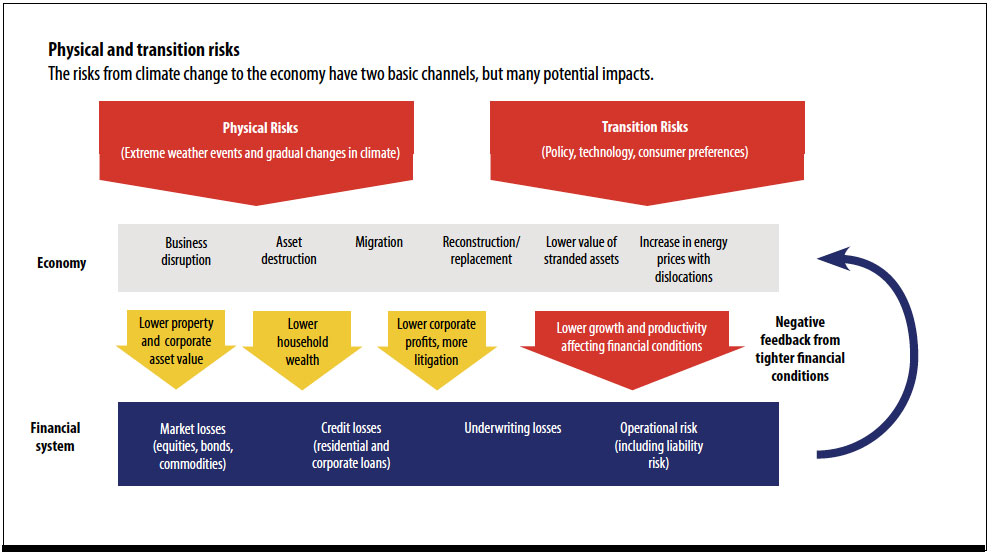End of 2019 IMF Report – Climate and Financial Risk
Climate change is already a reality. Ever more ferocious cyclones and extended droughts lead to the destruction of infrastructure and the disruption of livelihoods, and contribute to mass migration. Actions to combat rising temperatures, inadequate though they are, have the potential to drive dislocation in the business world as fossil fuel giants awaken to the need for renewable sources of energy and automakers accelerate investments in cleaner vehicles.
But measuring economic costs of climate change remains a work in progress. We can assess the immediate costs of changing weather patterns and more frequent and intense natural disasters, but most of the potential costs lie beyond the horizon of the typical economic analysis. The economic impact of climate change will likely accelerate, though not smoothly. Crucially for the coming generations, the extent of the damage will depend on policy choices that we make today.
Policymakers and investors increasingly recognize climate change’s important implications for the financial sector. Climate change affects the financial system through two main channels. The first involves physical risks, arising from damage to property, infrastructure, and land. The second, transition risk, results from changes in climate policy, technology, and consumer and market sentiment during the adjustment to a lower-carbon economy. Exposures can vary significantly from country to country. Lower- and middle-income economies are typically more vulnerable to physical risks.
For financial institutions, physical risks can materialize directly, through their exposures to corporations, households, and countries that experience climate shocks, or indirectly, through the effects of climate change on the wider economy and feedback effects within the financial system. Exposures manifest themselves through increased default risk of loan portfolios or lower values of assets. For example, rising sea levels and a higher incidence of extreme weather events can cause losses for homeowners and diminish property values, leading to greater risks in mortgage portfolios. Corporate credit portfolios are also at risk, as highlighted by the bankruptcy of California’s largest utility, Pacific Gas and Electric. In what The Wall Street Journal called the first “climate-change bankruptcy” (Gold 2019), rapid climatic changes caused prolonged droughts in California that dramatically increased the risk of fires from Pacific Gas and Electric’s operations. Tighter financial conditions might follow if banks reduce lending, in particular when climate shocks affect many institutions simultaneously.
For insurers and reinsurers, physical risks are important on the asset side, but risks also arise from the liability side as insurance policies generate claims with a higher frequency and severity than originally expected. Losses from natural disasters are already increasing. As a result, insurance is likely to become more expensive or even unavailable in at-risk areas of the world. Climate change can make banks, insurers, and reinsurers less diversified, because it can increase the likelihood or impact of events previously considered uncorrelated, such as droughts and floods.
Transition risks materialize on the asset side of financial institutions, which could incur losses on exposure to firms with business models not built around the economics of low carbon emissions. Fossil fuel companies could find themselves saddled with reserves that are, in the words of Bank of England Governor Mark Carney (2015), “literally unburnable” in a world moving toward a low-carbon global economy. These firms could see their earnings decline, businesses disrupted, and funding costs increase because of policy action, technological change, and consumer and investor demands for alignment with policies to tackle climate change. Coal producers, for example, already grapple with new or expected policies curbing carbon emissions, and a number of large banks have pledged not to provide financing for new coal facilities. The share prices of US coal mining companies reflect this “carbon discount” as well as higher financing costs and have been under performing relative to those of companies holding clean energy assets.
Risks can also materialize through the economy at large, especially if the shift to a low-carbon economy proves abrupt (as a consequence of prior inaction), poorly designed, or difficult to coordinate globally (with consequent disruptions to international trade). Financial stability concerns arise when asset prices adjust rapidly to reflect unexpected realizations of transition or physical risks. There is some evidence that markets are partly pricing in climate change risks, but asset prices may not fully reflect the extent of potential damage and policy action required to limit global warming to 2˚C or less.
Closing data gaps is also crucial. Only with accurate and adequately standardized reporting of climate risks in financial statements can investors discern companies’ actual exposures to climate-related financial risks. There are promising efforts to support private sector disclosures of such risks. But these disclosures are often voluntary and uneven across countries and asset classes. Comprehensive climate stress testing by central banks and supervisors would require much better data. The IMF supports public and private sector efforts to further spread the adoption of climate disclosures across markets and jurisdictions, particularly by following the recommendations of the Task Force on Climate-related Financial Disclosures (2017). Greater standardization would also improve the comparability of information in financial statements on climate risks.
The potential impact of climate change compels us to think through, in an empirical fashion, the economic costs of climate change. Each destructive hurricane and every unnaturally parched landscape will chip away at global output, just as the road to a low-carbon economy will escalate the cost of energy sources as externalities are no longer ignored and old assets are rendered worthless. On the other hand, carbon taxes and energy-saving measures that reduce the emission of greenhouse gases will drive the creation of new technologies. Finance will have to play an important role in managing this transition, for the benefit of future generations.
Read the entire report at IMF Finance & Development.



